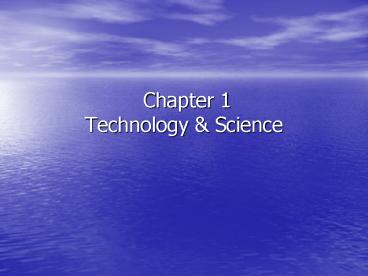Chapter 1 Technology - PowerPoint PPT Presentation
1 / 16
Title:
Chapter 1 Technology
Description:
Chapter 1 Technology & Science – PowerPoint PPT presentation
Number of Views:1526
Avg rating:3.0/5.0
Title: Chapter 1 Technology
1
Chapter 1 Technology Science
2
- State Performance Indicator
- ?SPI 0807.T/E.2-Evaluate a protocol to determine
if the engineering design process was
successfully applied. - ?SPI 0807.T/E.3-Distinguish between the intended
benefits and the unintended consequences of a new
technology. - ?SPI 0807.T/E.4-Differentiate between adaptive
and assistive engineered products (Ex food,
biofuels, medicines, integrated pest management).
3
What Is Technology?
- ?Technology refers to the products and processes
that are designed to serve our needs. - Technology also refers to the tools and methods
for creating these products. - Technology applies to any product, process, or
knowledge that is developed to meet a need.
4
- Engineering is the process of creating
technology. - Scientists, inventors, business owners, artists,
and even students have also engineered new
technologies. - Anyone can follow the engineering design process
to solve a problem or address a need.
5
How Does Science Relate to Technology?
- Engineering uses scientific knowledge to develop
technologies. - Engineers use science and mathematics to create
new technologies that serve human needs. - There are many different types of engineers who
develop a variety of very different products.
6
What is the Engineering Design Process?
- The engineering design process has similarities
to the scientific process. - Like the scientific process, some steps may
require repeating or modifying to fit different
needs.
7
Step 1 Ask Identifying Researching a Need
- Engineers define and describe the need or problem
they are trying to solve. - Research provides engineers with information for
problem solving.
8
Step 2 Imagine Developing Possible Solutions
- Brainstorming is the process in which a group of
people share ideas quickly to promote additional
ideas. - Sometimes a possible solution to the problem
comes from these ideas or it may take more time
and thought.
9
Step 3 Plan Making a prototype
- A prototype is a test model of the product.
- Prototypes allow engineers to see if their design
works the way they expect it to.
10
Step 4 Create Testing and Evaluating
- Prototypes are tested and evaluated.
- Engineers complete a cost-benefit analysis to
make sure that the cost of designing and
producing the new product is worth its benefit.
11
Step 5 Improve Modifying Retesting the Solution
- If a prototype was not successful or did not work
well, engineers would either modify their
prototype or try a new solution. - It is important that the engineers consider what
was learned from the first prototype before they
begin the design process again.
12
Step 6 Communication
- Engineers often need to share their successes,
failures, and reasoning with others. - Engineers may explain and promote the technology
to customers, or they may communicate with the
public through news releases, advertisements, or
journals.
13
(No Transcript)
14
Technology and Society
- Technology provides solutions for many types of
social, political, and economic needs. - Intended Benefit- An intended benefit is the
positive purpose for which a technology is
designed to be used. - Unintended Consequences- Unintended consequences
are uses or results that engineers do not
purposely include in the design of products. An
unintended consequence can be beneficial.
15
What is Bioengineering?
- The application of engineering to living things,
such as humans and plants, is called
bioengineering. - Bioengineered technologies can be classified as
either assistive or adaptive.
16
- Assistive technologies are developed to help
organisms without changing them. Such as glasses,
contacts, crutches, wheel chair, cane, hearing
aid - Adaptive bioengineered products change the
living organism. Such as cochlear implant, pace
maker, organ transplant, bioengineered products
(corn)































